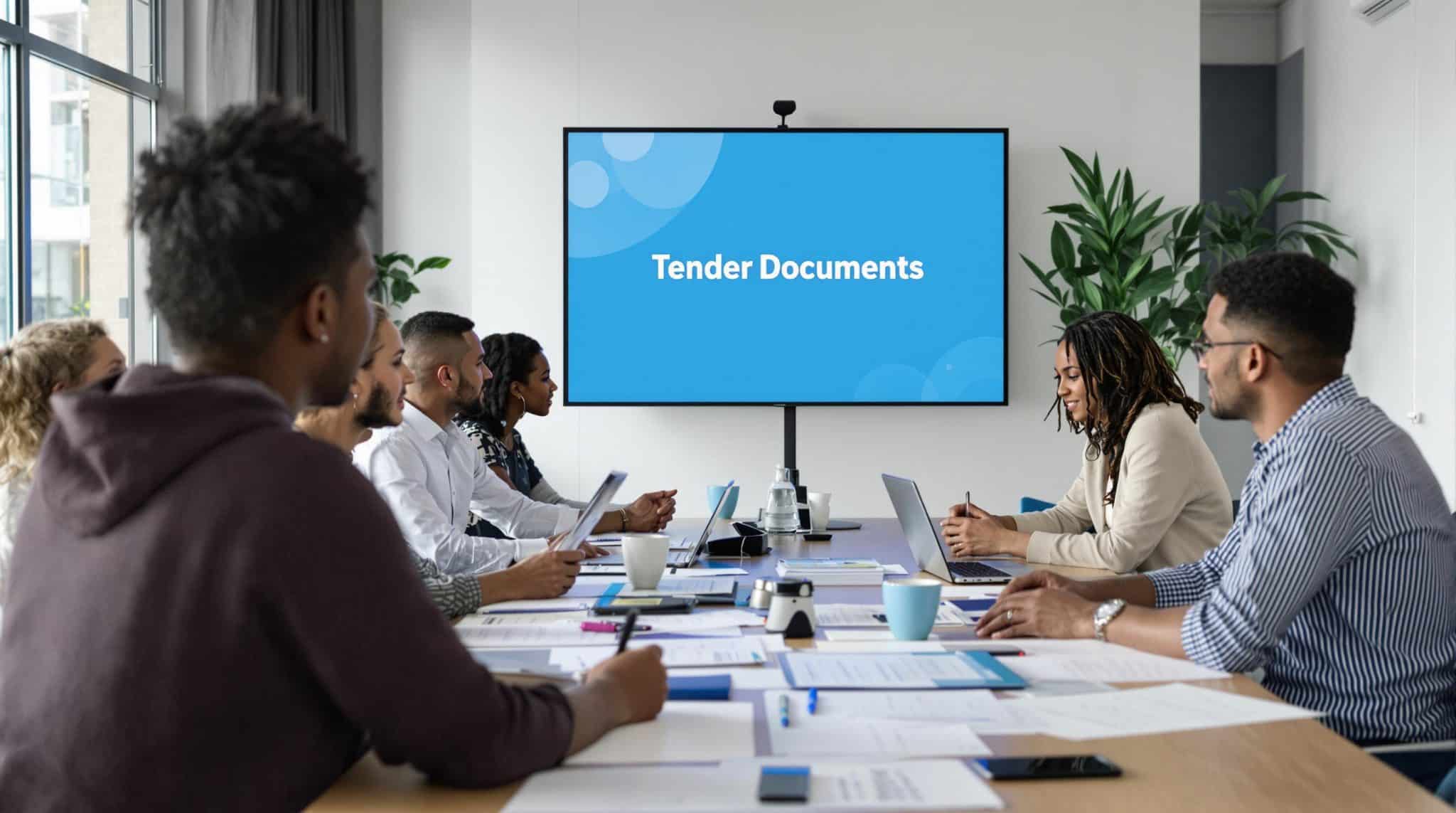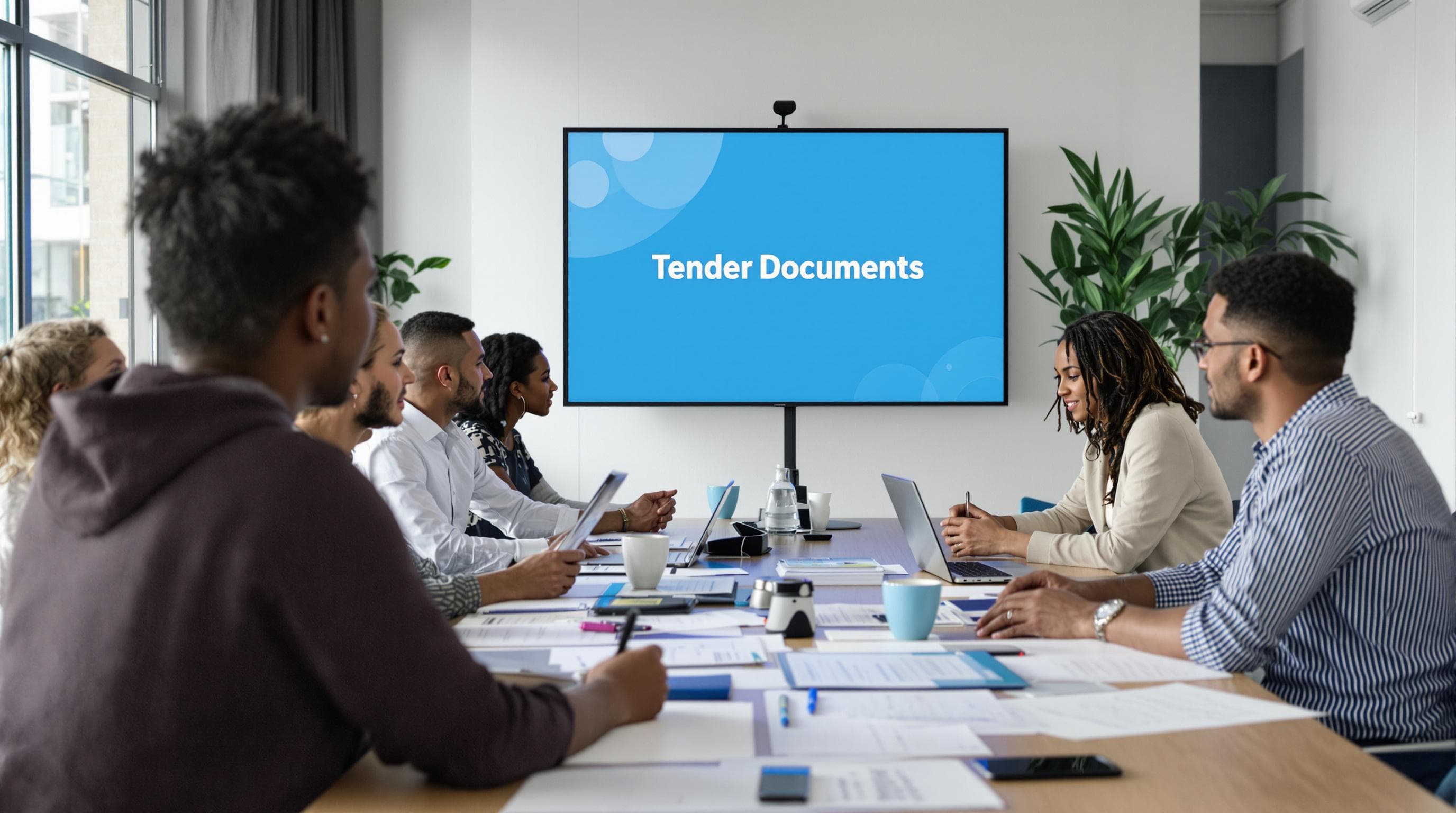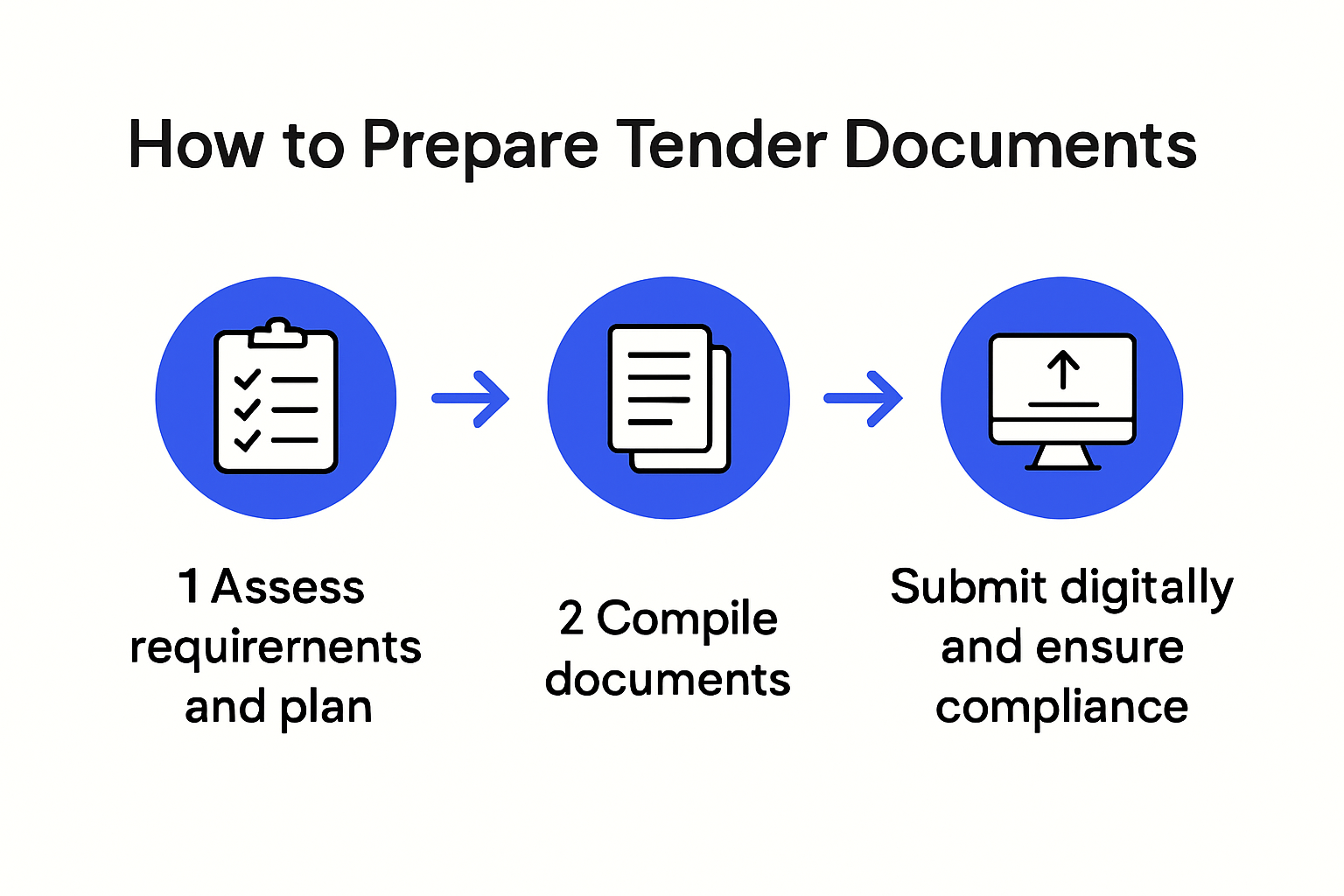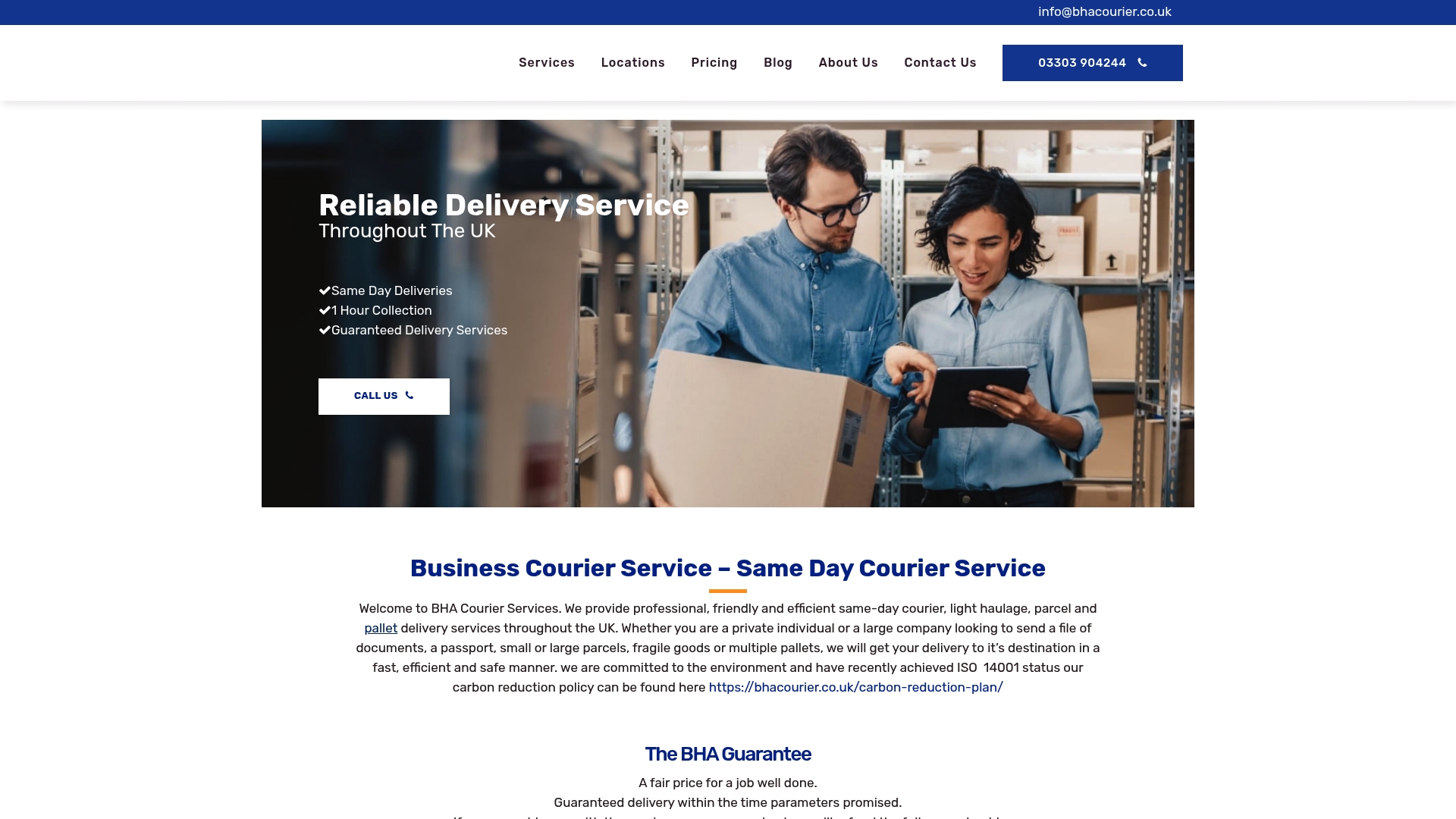
17 Jul How to Prepare Tender Documents: A 2025 Guide for UK Businesses

Every year, UK organisations miss out on millions in public contracts because their tender documents lack clarity or key details. Here’s a shocker. Over 30 percent of bids are rejected due to common documentation errors. What many do not realise is that in 2025, mastering the new requirements does not just prevent disqualification, it actually opens the door to more lucrative and sustainable deals than ever before.
Table of Contents
- Understanding Tender Document Requirements
- Key Steps In Preparing Tender Documents
- Common Mistakes And How To Avoid Them
- Winning Tips For UK Businesses In 2025
Quick Summary
| Takeaway | Explanation |
|---|---|
| Prepare Comprehensive Tender Documents | Include essential components such as contracting authority details, contract subject matter, estimated contract value, submission procedures, and assessment criteria to ensure clarity and transparency. |
| Conduct Strategic Bid Planning | Evaluate resource availability, technical competence, financial viability, and competitive positioning before proceeding with tender preparation to make informed decisions. |
| Avoid Common Mistakes | Develop a systematic approach to understanding tender requirements, ensuring documentation accuracy and compliance to prevent disqualification due to misunderstandings or errors. |
| Embrace Digital Tendering Solutions | Leverage e-tendering platforms to enhance document management, improve collaboration, and streamline submission processes for greater efficiency in tender preparation. |
| Adapt to New Procurement Regulations | Align tender responses with the Most Advantageous Tender criterion by showcasing social value, sustainability, and innovation to enhance bidding competitiveness in 2025. |

Understanding Tender Document Requirements
Tender documents are critical communication tools that outline the precise requirements, expectations, and evaluation criteria for potential suppliers bidding on business contracts. Preparing comprehensive tender documents requires meticulous attention to detail and a strategic approach to ensuring clarity and fairness in the procurement process.
Key Components of Effective Tender Documentation
Preparing robust tender documents involves assembling multiple critical elements that provide potential suppliers with a comprehensive understanding of the contract requirements. The Procurement Act 2023 mandates specific inclusions that help create transparent and equitable bidding processes.
Tender documents must encompass several fundamental components:
- Contracting Authority Details: Clear identification of the organisation seeking bids
- Contract Subject Matter: Precise description of goods, services, or works required
- Estimated Contract Value: Financial parameters and budget constraints
- Submission Procedures: Explicit guidelines for bid preparation and submission
- Assessment Criteria: Transparent evaluation metrics for comparing potential suppliers
These elements form the foundation of a well-structured tender document, enabling suppliers to understand exactly what is expected and how their proposals will be evaluated.

Technical Specifications and Performance Requirements
When developing tender documents, organisations must strike a delicate balance between providing sufficient detail and maintaining flexibility for innovative solutions. Government procurement guidance recommends prioritising performance or functional requirements over prescriptive design specifications.
This approach encourages suppliers to propose creative solutions that meet the core objectives while potentially offering more cost-effective or technologically advanced approaches. Technical specifications should focus on the outcomes desired rather than dictating exact methodologies, which allows for greater competition and innovation among potential bidders.
A comprehensive tender document goes beyond mere technical requirements. It must also clearly communicate:
- Contractual terms and conditions
- Compliance expectations
- Quality standards
- Delivery timelines
- Potential risk allocations
By providing a holistic view of the project or contract, organisations can attract high-quality bids from suppliers who fully understand the scope and expectations of the opportunity.
Ultimately, well-prepared tender documents serve as a critical communication tool that bridges the gap between an organisation’s needs and potential suppliers’ capabilities. They represent more than a simple request for services – they are a strategic document that sets the stage for successful procurement and potential long-term business relationships.
To make it easier to identify the key required elements in tender documentation, the following table groups the fundamental components and their purposes:
| Component | Purpose |
|---|---|
| Contracting Authority Details | Identify the organisation seeking bids |
| Contract Subject Matter | Describe goods, services, or works required |
| Estimated Contract Value | Define financial parameters and budget constraints |
| Submission Procedures | Provide bid preparation and submission guidelines |
| Assessment Criteria | Outline evaluation metrics for comparing suppliers |
| Contractual Terms and Conditions | State legal and commercial expectations |
| Compliance Expectations | Set out regulatory and statutory requirements |
| Quality Standards | Clarify performance and quality benchmarks |
| Delivery Timelines | Specify when outputs are due |
| Risk Allocations | Explain how risks are shared or transferred |
Key Steps in Preparing Tender Documents
Successful tender preparation requires a systematic and strategic approach that transforms complex requirements into a compelling, compliant bid. Tender document preparation is not merely an administrative task but a critical business process that demands precision, research, and meticulous planning.
Strategic Bid Planning and Initial Assessment
Before diving into document creation, businesses must conduct a comprehensive internal evaluation to determine their readiness and suitability for the tender opportunity. Crown Commercial Service guidance emphasises the importance of strategic bid planning.
Key considerations during this initial phase include:
- Resource Availability: Assess current workforce capabilities and potential capacity constraints
- Technical Competence: Evaluate whether existing skills match the tender requirements
- Financial Viability: Determine if the potential contract aligns with the organisation’s financial objectives
- Competitive Positioning: Understand unique value propositions that differentiate the bid
This preliminary assessment helps organisations make informed decisions about whether to pursue a tender and how to position their proposal effectively.
Comprehensive Document Compilation
Once an organisation decides to proceed, the next critical step involves assembling a comprehensive tender document package. East Staffordshire Borough Council procurement guidelines provide detailed insights into the essential components required.
A robust tender document should include:
- Detailed technical specifications
- Clear pricing structures
- Precise contractual terms and conditions
- Comprehensive evaluation criteria
- Evidence of organisational capabilities
- Compliance documentation
Each section must be crafted with extreme clarity, leaving no room for ambiguity or misinterpretation. The goal is to provide potential clients with a transparent, comprehensive understanding of the proposed solution.
Digital Tendering and Documentation Management
Modern tender preparation increasingly relies on digital platforms and e-tendering solutions to enhance efficiency and transparency. The Institute of Chartered Accountants in England and Wales highlights the advantages of electronic tendering systems.
Digital tendering offers multiple benefits:
- Streamlined document exchange
- Enhanced audit trail capabilities
- Reduced administrative costs
- Improved collaboration mechanisms
- Greater accessibility for potential bidders
Organisations should invest in robust digital platforms that facilitate secure, efficient tender document management while maintaining compliance with procurement regulations.
Successful tender document preparation is an intricate process that demands strategic thinking, attention to detail, and a comprehensive understanding of both the organisation’s capabilities and the client’s requirements. By following a structured approach and leveraging digital tools, businesses can significantly improve their chances of submitting winning bids.
To clarify the sequence of activities, the following table summarises the key steps in preparing tender documents:
| Step | Description |
|---|---|
| Strategic Bid Planning | Assess resources, skills, finances, and competitive position before deciding to bid |
| Initial Assessment | Evaluate suitability for the opportunity and readiness |
| Document Compilation | Assemble technical specs, pricing, terms, evaluation criteria, and compliance documents |
| Digital Documentation Management | Use e-tendering platforms for secure, efficient document handling |
| Final Review and Submission | Verify completeness, compliance, and timeliness before submitting the tender |
Common Mistakes and How to Avoid Them
Navigating the complex landscape of tender document preparation requires vigilance and strategic planning. Tender submissions are high-stakes processes where even minor errors can result in significant consequences, potentially costing businesses valuable opportunities.
Misinterpreting Tender Requirements
One of the most critical errors organisations make is failing to thoroughly understand tender specifications. Thornton and Lowe procurement experts emphasise that misinterpreting requirements can lead to immediate disqualification.
Common misinterpretation pitfalls include:
- Superficial Document Review: Skimming instead of carefully reading entire tender documentation
- Assumption Traps: Making assumptions about requirements without seeking clarification
- Overlooking Subtle Details: Missing nuanced specifications that could impact bid compliance
- Ignoring Evaluation Criteria: Failing to align submission precisely with stated assessment parameters
To mitigate these risks, organisations should develop a systematic approach to tender document review, including creating detailed checklists and scheduling multiple comprehensive document reviews.
Documentation and Compliance Challenges
Supply2Gov Tenders guidance highlights the critical importance of comprehensive and accurate documentation. Incomplete or incorrect submissions can instantly disqualify otherwise competitive bids.
Key documentation mistakes to avoid:
- Submitting incomplete forms
- Providing inconsistent information across documents
- Failing to include mandatory supporting evidence
- Neglecting specific formatting requirements
- Missing submission deadlines
Implementing a robust document verification process can help organisations ensure all required materials are accurately prepared and submitted.
Quality Standards and Compliance Considerations
Complete Tenders professional insights underscore the significance of demonstrating comprehensive compliance and quality standards.
Critical compliance strategies include:
- Maintaining up-to-date certifications
- Providing clear evidence of quality management systems
- Demonstrating regulatory adherence
- Including third-party validation where appropriate
- Presenting transparent performance histories
Successful tender preparation demands meticulous attention to detail, a comprehensive understanding of requirements, and a proactive approach to potential challenges. By anticipating common pitfalls and developing strategic mitigation strategies, organisations can significantly enhance their tender submission success rates.
Remember that tender preparation is not just about meeting minimum requirements but about presenting a compelling, professional, and differentiated proposal that demonstrates genuine value and capability.
Winning Tips for UK Businesses in 2025
As the procurement landscape continues to evolve, UK businesses must adapt their tender strategies to remain competitive in an increasingly complex marketplace. Tender preparation in 2025 demands a sophisticated approach that goes beyond traditional bidding methods.
Strategic Positioning Under New Procurement Regulations
Enterprise Nation’s procurement experts highlight significant changes introduced by the Procurement Act 2025, which fundamentally transforms how businesses approach public sector contracts. The new legislation introduces a “Most Advantageous Tender” (MAT) criterion that evaluates bids beyond simple price comparisons.
Key strategic considerations for businesses include:
- Social Value Demonstration: Showcasing broader economic, environmental, and social impacts
- Sustainability Credentials: Highlighting environmental and ethical business practices
- Innovation Potential: Presenting unique solutions that add exceptional value
- Transparent Performance Metrics: Providing clear evidence of past successes
Businesses must now craft tender responses that tell a comprehensive story about their capabilities and potential broader contributions.
Streamlining Documentation and Registration
The 2025 procurement landscape introduces a revolutionary “tell us once” registration process. Enterprise Nation guidance explains this simplification will dramatically reduce administrative burdens for suppliers.
To maximize opportunities, businesses should:
- Maintain a comprehensive, constantly updated digital business profile
- Invest in digital documentation management systems
- Create standardised response templates
- Develop robust compliance tracking mechanisms
- Implement efficient information retrieval processes
Modern businesses need to treat their tender preparation as a strategic function, not just an administrative task. Our Bristol courier services demonstrate how local businesses can leverage specialized expertise to enhance their competitive positioning.
Navigating New Procurement Procedures
Enterprise Nation’s analysis reveals two primary procurement procedures businesses must understand:
- Open Procedure: Suitable for straightforward, transparent procurements
- Competitive Flexible Procedure: Allowing customized tendering approaches
Successful businesses in 2025 will characterize themselves by:
- Agile response capabilities
- Digital transformation readiness
- Comprehensive compliance understanding
- Strategic value proposition development
- Continuous learning and adaptation
The tender landscape of 2025 demands more than just meeting minimum requirements. It requires businesses to position themselves as innovative, responsible, and strategically aligned partners who can deliver exceptional value across multiple dimensions.
Ultimately, winning tenders is about presenting a holistic narrative that demonstrates not just capability, but genuine potential to transform and elevate the contracting organization’s objectives.
Frequently Asked Questions
What are the key components of effective tender documentation?
Effective tender documentation should include contracting authority details, a precise contract subject matter, estimated contract value, submission procedures, and clear assessment criteria to ensure clarity and transparency in the bidding process.
How can businesses avoid common mistakes in tender preparation?
To avoid common mistakes, organisations should thoroughly review tender requirements, prepare comprehensive documentation, ensure compliance with regulations, and conduct multiple reviews to check for accuracy and completeness before submission.
What role does digital tendering play in preparing tender documents?
Digital tendering enhances efficiency by streamlining document management, improving collaboration, and ensuring better compliance with procurement regulations, making the submission process more transparent and accessible for potential bidders.
How has the Procurement Act 2025 changed the tendering landscape for UK businesses?
The Procurement Act 2025 introduces the Most Advantageous Tender (MAT) criterion, which focuses on broader assessments of bids such as social value, sustainability, and innovation, transforming how businesses approach public sector contracts.
Secure Your Tender Success With Fast, Dependable Document Delivery
Getting every detail right in your tender documents is vital, but none of it matters if your submission does not arrive on time or intact. As highlighted in the article, one small mistake or late delivery can cost you a major contract. When speed and reliability are not optional, you need solutions that ensure your completed tender paperwork reaches its destination safely and before the deadline. Trust matters as much as precision. With so much at stake for your business, why leave delivery to chance?

Let BHA Courier be part of your tender preparation strategy. Our same-day and next-day courier services give you peace of mind, from urgent bids to sensitive documents. We offer secure handling for time-sensitive materials and support for fragile or high-value items, all across the UK. You can easily book online, track your shipment, and benefit from our nationwide network. Do not let logistics be the reason you miss an opportunity. Visit BHA Courier today and experience how our trusted document delivery can help safeguard your next tender submission. The right delivery partner makes all the difference—get started now to make your bid stand out for the right reasons.

Sorry, the comment form is closed at this time.